Steady-State Conduction Current Performance for Multilayer Polyimide/SiO2 Films
Abstract
1. Introduction
2. Experimental Section
2.1. Sample Synthesis Procedure
2.2. Spin Coating Technique to Cast PI Films
2.3. PI Films Fluorination
2.4. Composition of Multilayer Films and SEM
2.5. Measurements
- (1)
- the orientation of dipoles;
- (2)
- displacement of the positive and negative charges;
- (3)
- shifting of mobile positive and negative carriers (Maxwell-Wagner-Sillars polarization); and
- (4)
- space charge injection from electrodes and its accumulation in the bulk of the sample.
3. Results
4. Conclusions
Author Contributions
Funding
Institutional Review Board Statement
Informed Consent Statement
Data Availability Statement
Conflicts of Interest
References
- Akram, S.; Wang, P.; Nazir, M.T.; Zhou, K.; Bhutta, M.S.; Hussain, H. Impact of impulse voltage frequency on the partial discharge characteristic of electric vehicles motor insulation. Eng. Fail. Anal. 2020, 116, 104767. [Google Scholar] [CrossRef]
- Lai, G.-H.; Huang, T.-C.; Tseng, I.-H.; Huang, B.-S.; Yang, T.-I.; Tsai, M.-H. Transparency anticorrosion coatings prepared from alumina-covered graphene oxide/polyimide nanocomposites. Express Polym. Lett. 2019, 13, 772–784. [Google Scholar] [CrossRef]
- Sousa, J.; Marques, J.; Garcia, M.; Infante, V.; Amaral, P. Mechanical characterization of sandwich composites with embedded sensors. Eng. Fail. Anal. 2020, 117, 104765. [Google Scholar] [CrossRef]
- Lee, Y.-C.; Ahn, J.-H.; Lee, C.-Y. Grid-type sensors using resistance change ratio for micro-crack detection. Eng. Fail. Anal. 2021, 119, 104973. [Google Scholar] [CrossRef]
- Kronenberg, P.; Rastogi, P.K.; Giaccari, P.; Limberger, H.G. Relative humidity sensor with optical fiber Bragg gratings. Opt. Lett. 2002, 27, 1385. [Google Scholar] [CrossRef] [PubMed]
- Lin, D.; Liu, Y.; Cui, Y. Reviving the lithium metal anode for high-energy batteries. Nat. Nanotechnol. 2017, 12, 194–206. [Google Scholar] [CrossRef]
- Zhao, J.; Kang, T.; Chu, Y.; Chen, P.; Jin, F.; Shen, Y.; Chen, L. A polyimide cathode with superior stability and rate capability for lithium-ion batteries. Nano Res. 2019, 12, 1355–1360. [Google Scholar] [CrossRef]
- Palneedi, H.; Peddigari, M.; Hwang, G.-T.; Jeong, D.-Y.; Ryu, J. High-Performance Dielectric Ceramic Films for Energy Storage Capacitors: Progress and Outlook. Adv. Funct. Mater. 2018, 28, 1803665. [Google Scholar] [CrossRef]
- Akram, S.; Castellon, J.; Kai, Z.; Agnel, S.; Habas, J.-P.; Nazir, M.T. Dielectric properties and modeling of multilayer polyimide nanocomposite to highlight the impact of nanoparticles dispersion. IEEE Trans. Dielectr. Electr. Insul. 2020, 27, 1238–1246. [Google Scholar] [CrossRef]
- Akram, S.; Gao, G.; Liu, Y.; Zhu, J.; Wu, G. Degradation mechanism of A12O3 nano filled polyimide film due to surface discharge under square impulse voltage. IEEE Trans. Dielectr. Electr. Insul. 2015, 22, 3341–3349. [Google Scholar] [CrossRef]
- Akram, S.; Yang, Y.; Zhong, X.; Bhutta, S.; Wu, G.; Castellon, J.; Zhou, K. Influence of nano layer structure of polyimide film on space charge behavior and trap levels. IEEE Trans. Dielectr. Electr. Insul. 2018, 25, 1461–1469. [Google Scholar] [CrossRef]
- Akram, S.; Castellon, J.; Agnel, S.; Habas, J.-P. Synthesis Process Optimization of Polyimide Nanocomposite Multilayer Films, Their Dielectric Properties, and Modeling. In Polyimide for Electronic and Electrical Engineering Applications; IntechOpen: London UK, 2020. [Google Scholar]
- Haq, S.U. A Study on Insulation Problems in Drive Fed Medium Voltage Induction Motors. Ph.D. Thesis, Department of Electrical and Computer Engineering, University of Waterloo, Waterloo, ON, Canada, 2007. [Google Scholar]
- Kaufhold, M.; Aninger, H.; Berth, M.; Speck, J.; Eberhardt, M. Electrical stress and failure mechanism of the winding insulation in PWM-inverter-fed low-voltage induction motors. IEEE Trans. Ind. Electron. 2000, 47, 396–402. [Google Scholar] [CrossRef]
- Akram, S.; Nazir, M.T.; Castellon, J.; Agnel, S.; Zhou, K.; Bhutta, M.S.; Kai, Z. Preparation and distinguish dielectric properties of multi-layer nanoparticles-based polyimide films. Mater. Res. Express 2019, 6, 125092. [Google Scholar] [CrossRef]
- Yang, Y.; He, J.; Wu, G.; Hu, J. “Thermal Stabilization Effect” of Al2O3 nano-dopants improves the high-temperature dielectric performance of polyimide. Sci. Rep. 2015, 5, 1–10. [Google Scholar] [CrossRef] [PubMed]
- Bhutta, M.S.; Yang, L.; Ma, Z.; Nazir, M.T.; Akram, S.; Mehmood, M.A.; Faiz, N. Simulation of thickness controlled DC breakdown of XLPE regulated by space charge & molecular chain movement. IEEE Trans. Dielectr. Electr. Insul. 2020, 27, 1143–1151. [Google Scholar] [CrossRef]
- Meng, P.; Zhao, X.; Yang, X.; Wu, J.; Xie, Q.; He, J.; Hu, J.; He, J. Breakdown phenomenon of ZnO varistors caused by non-uniform distribution of internal pores. J. Eur. Ceram. Soc. 2019, 39, 4824–4830. [Google Scholar] [CrossRef]
- Nazir, M.T.; Phung, B.T.; Li, S.; Akram, S.; Mehmood, M.A.; Yeoh, G.H.; Hussain, S. Effect of micro-nano additives on breakdown, surface tracking and mechanical performance of ethylene propylene diene monomer for high voltage insulation. J. Mater. Sci. Mater. Electron. 2019, 30, 14061–14071. [Google Scholar] [CrossRef]
- Nazir, M.T.; Butt, F.T.; Phung, B.T.; Yeoh, G.H.; Yasin, G.; Akram, S.; Bhutta, M.S.; Hussain, S.; Nguyen, T.A. Simulation and Experimental Investigation on Carbonized Tracking Failure of EPDM/BN-Based Electrical Insulation. Polymers 2020, 12, 582. [Google Scholar] [CrossRef] [PubMed]
- Zhong, X.; Shakeel, A.; Yang, Y.; Gao, G.; Wu, G. Preparation and corona-resistance characteristics of double-layer polyimide/Al2O3 nanocomposite film. In Proceedings of the 2016 IEEE International Conference on High Voltage Engineering and Application (ICHVE), Chengdu, China, 19–22 September 2016; pp. 1–4. [Google Scholar] [CrossRef]
- Butt, F.T.; Nazir, M.T.; Hussain, H.; Phung, B.T.; Akram, S.; Bhutta, M.S.; Yasin, G. Physical, thermal and partial discharge evaluation of nano alumina filled silicone rubber in inclined plane test. CSEE J. Power Energy Syst. 2020. [Google Scholar] [CrossRef]
- Wang, P.; Hui, S.; Akram, S.; Zhou, K.; Nazir, M.T.; Chen, Y.; Dong, H.; Javed, M.S.; Haq, I.U. Influence of Repetitive Square Voltage Duty Cycle on the Electrical Tree Characteristics of Epoxy Resin. Polymers 2020, 12, 2215. [Google Scholar] [CrossRef]
- Bhutta, M.S.; Yang, L.; Ma, Z.; Ahmad, J.; Mehmood, M.A. Influence of Polyhedral Oligomeric Silsesquioxane (POSS) on Space Charge Behavior and Trap Levels of XLPE/POSS nanocomposite. In Proceedings of the 2018 IEEE 2nd International Conference on Dielectrics (ICD), Budapest, Hungary, 1–5 July 2018; p. 4. [Google Scholar]
- Meng, P.; Wu, J.; Yang, X.; Hu, J.; He, J. Electrical properties of ZnO varistor ceramics modified by rare earth-yttrium and gallium dopants. Mater. Lett. 2018, 233, 20–23. [Google Scholar] [CrossRef]
- Bokobza, L. Multiwall carbon nanotube-filled natural rubber: Electrical and mechanical properties. Express Polym. Lett. 2012, 6, 213–223. [Google Scholar] [CrossRef]
- Ghorpade, R.V.; Rajan, C.R.; Chavan, N.N.; Ponrathnam, S. Synthesis of novel silica-polyimide nanocomposite films using aromatic-amino modified silica nanoparticles: Mechanical, thermal and morphological investigations. Express Polym. Lett. 2015, 9, 469–479. [Google Scholar] [CrossRef]
- Hu, J.; Gu, A.; Liang, G.; Zhuo, D.; Yuan, L. Preparation and properties of mesoporous silica/bismaleimide/diallylbisphenol composites with improved thermal stability, mechanical and dielectric properties. Express Polym. Lett. 2011, 5, 555–568. [Google Scholar] [CrossRef]
- Spoljaric, S.; Shanks, R.A. Novel elastomer dye-functionalised POSS nanocomposites: Enhanced colourimetric, thermomechanical and thermal properties. Express Polym. Lett. 2012, 6, 354–372. [Google Scholar] [CrossRef]
- Akram, S.; Castellon, J.; Agnel, S.; Khan, M.Z. Space charge analysis of multi-structure polyimide films using TSM. In Proceedings of the IEEE Conference on Electrical Insulation and Dielectric Phenomena (CEIDP), Cancun, Mexico, 21–24 October 2018; pp. 34–37. [Google Scholar]
- Akram, S.; Zhou, K.; Meng, P.F.; Castellon, J.; Agnel, S.; Wang, P.; Nazir, M.T.; Chen, Y.; Hussain, H. Charge Transport and Trapping of Surface Modified Stator Coil Insulation of Motors. IEEE Trans. Dielect. Electr. Insul. 2021, in press. [Google Scholar]
- Castellon, J.; Nguyen, H.N.; Agnel, S.; Toureille, A.; Frechette, M.; Savoie, S.; Krivda, A.; Schmidt, L. Electrical properties analysis of micro and nano composite epoxy resin materials. IEEE Trans. Dielectr. Electr. Insul. 2011, 18, 651–658. [Google Scholar] [CrossRef]
- Diaham, S.; Saysouk, F.; Locatelli, M.-L.; Lebey, T. Huge improvements of electrical conduction and dielectric breakdown in polyimide/BN nanocomposites. IEEE Trans. Dielectr. Electr. Insul. 2016, 23, 2795–2803. [Google Scholar] [CrossRef]
- Yahyaoui, H.; Notingher, P.; Agnel, S.; Kieffel, Y.; Girodet, A. Analysis of conduction mechanisms in alumina-filled epoxy resin under dc field and temperature. In Proceedings of the 2013 Annual Report Conference on Electrical Insulation and Dielectric Phenomena, Shenzhen, China, 20–23 October 2013; pp. 667–670. [Google Scholar] [CrossRef]
- Bhumiwat, S.A. Advanced Applications of Polarisation/Depolarisation Current Analysis on Power Transformers. In Proceedings of the Conference Record of the 2008 IEEE International Symposium on Electrical Insulation, Vancouver, BC, Canada, 9–12 June 2008; pp. 474–477. [Google Scholar] [CrossRef]
- Zhu, Y.B.; Ang, L.K. Analytical re-derivation of space charge limited current in solids using capacitor model. J. Appl. Phys. 2011, 110, 094514. [Google Scholar] [CrossRef]
- Rose, A. Space-Charge-Limited Currents in Solids. Phys. Rev. 1955, 97, 1538–1544. [Google Scholar] [CrossRef]
- Mott, N.F.; Gurney, R.W. Electronic processes in ionic crystals. J. Phys. Chem. 1941, 45, 1142. [Google Scholar] [CrossRef]
- Chen, Y.; Wang, Y.; Wu, J.; Yin, Y. Study on conduction current characteristics of corona-resistant polyimide film before and after thermal aging. In Proceedings of the 2017 International Symposium on Electrical Insulating Materials (ISEIM), Toyohashi, Japan, 11–15 September 2017; Volume 2, pp. 605–608. [Google Scholar] [CrossRef]
- Ieda, M.; Mizutani, T.; Ikeda, S. Electrical Conduction and Chemical Structure of Insulating Polymers. IEEE Trans. Electr. Insul. 1986, -EI-21, 301–306. [Google Scholar] [CrossRef]
- Lan, L.; Wu, J.; Yin, Y.; Li, X.; Li, Z. Effect of temperature on space charge trapping and conduction in cross-linked polyethylene. IEEE Trans. Dielectr. Electr. Insul. 2014, 21, 1784–1791. [Google Scholar] [CrossRef]
- Fofana, I.; Hemmatjou, H.; Farzaneh, M.; Gockenbach, E.; Borsi, H. Polarization and Depolarization Current measurements of oil impregnated paper insulation system under thermal runaway. In Proceedings of the 2010 10th IEEE International Conference on Solid Dielectrics, Potsdam, Germany, 4–9 July 2010; pp. 1–4. [Google Scholar] [CrossRef]
- Dunson, D.L. Synthesis and Characterization of Thermosetting Polyimide Oligomers for Microelectronics Packaging. Ph.D. Thesis, Department of Chemistry, Virginia Polytechnic Institute and State University, Blacksburg, VA, USA, 2000. [Google Scholar]
- Akram, S.; Castellon, J.; Agnel, S.; Zhou, K.; Habas, J.-P.; Nazir, M.T. Multilayer polyimide nanocomposite films synthesis process optimization impact on nanoparticles dispersion and their dielectric performance. J. Appl. Polym. Sci. 2021, 138, 49715. [Google Scholar] [CrossRef]
- Critchley, P.; Knight, G.J.; Wright, W.W. Heat-Resistant Polymers: Technologically Useful Materials; Springer US: New York, NY, USA, 1983. [Google Scholar]
- Preda, I.; Castellon, J.; Agnel, S.; Notingher, P.; Frechette, M.; Heid, T.; Couderc, H.; Freebody, N.; Vaughan, A.S. Conduction currents and time to frequency domain transformation for epoxy resin nanocomposites. In Proceedings of the 2013 IEEE International Conference on Solid Dielectrics (ICSD), Bologna, Italy, 30 June–4 July 2013; pp. 1060–1063. [Google Scholar] [CrossRef]
- Li, C.Y.; Lin, C.J.; Chen, G.; Tu, Y.P.; Zhou, Y.; Li, Q.; Zhang, B.; He, J.L. Field-dependent charging phenomenon of HVDC spacers based on dominant charge behaviors. Appl. Phy. Lett. 2019, 114, 202904. [Google Scholar] [CrossRef]
- Du, B.X.; Guo, Y.G. Effects of surface fluorination on dielectric properties and surface charge behavior of water absorbed polyimide film. IEEE Trans. Dielectr. Electr. Insul. 2015, 22, 1369–1375. [Google Scholar] [CrossRef]
- Akram, S.; Wu, G.; Gao, G.; Liu, Y. Effect of surface discharge on nano filled polyimide film under square voltage. In Proceedings of the 2015 IEEE Electrical Insulation Conference (EIC), Seattle, WA, USA, 7–10 June 2015; pp. 226–229. [Google Scholar] [CrossRef]
- Li, C.Y.; Hu, J.; Lin, C.J.; He, J.L. The control mechanism of surface traps on surface charge behavior in alumina-filled epoxy composites. J. Phy. D Appl. Phy. 2016, 49, 445304. [Google Scholar] [CrossRef]
- Kim, T.Y.; Kim, W.G.; Lee, T.H.; Kim, J.E.; Yoon, H.G.; Suh, K.S. Electrical conduction of polyimide films prepared from polyamic acid (PAA) and pre-imidized polyimide (PI) solution. e-Polymers 2008, 8. [Google Scholar] [CrossRef][Green Version]
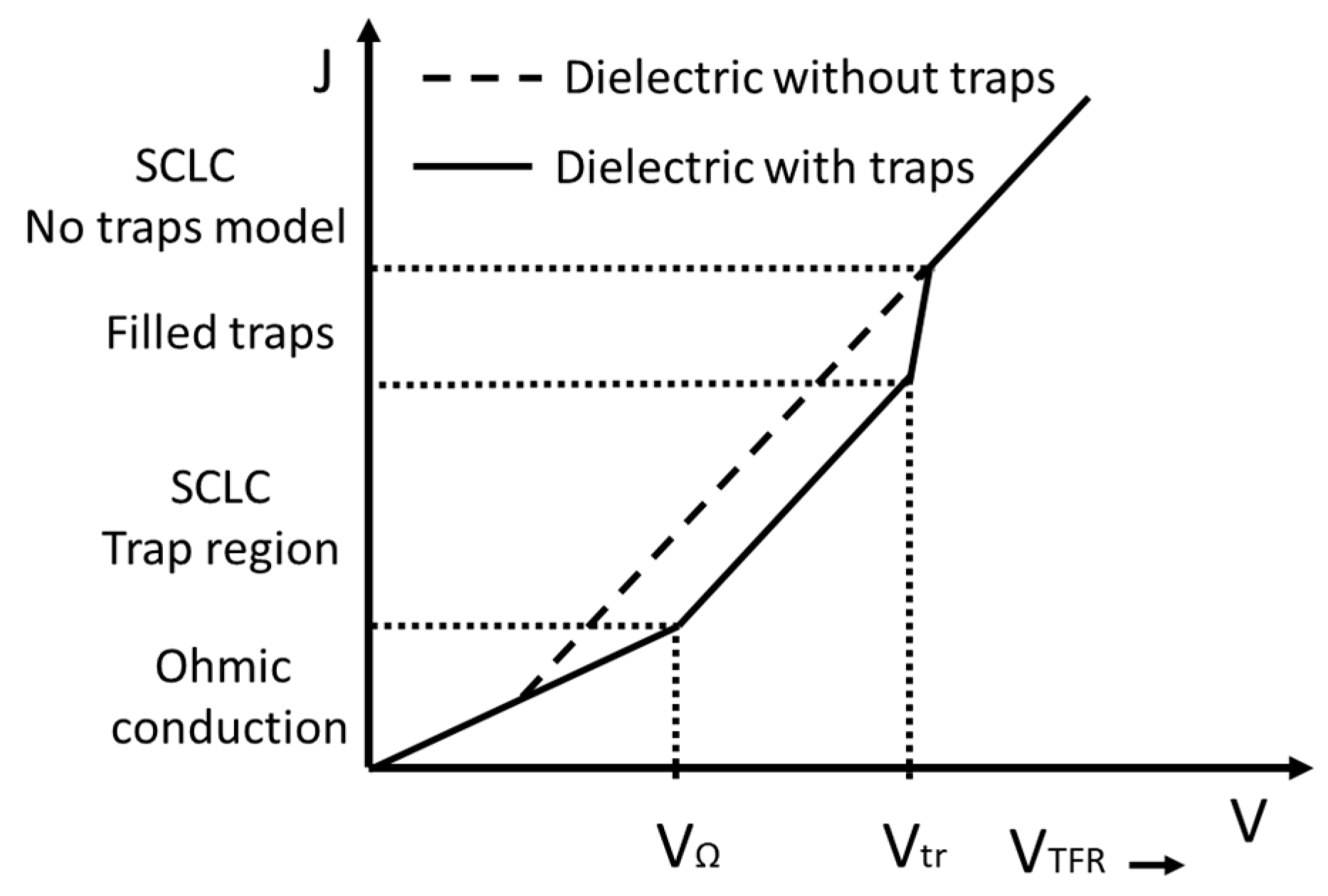
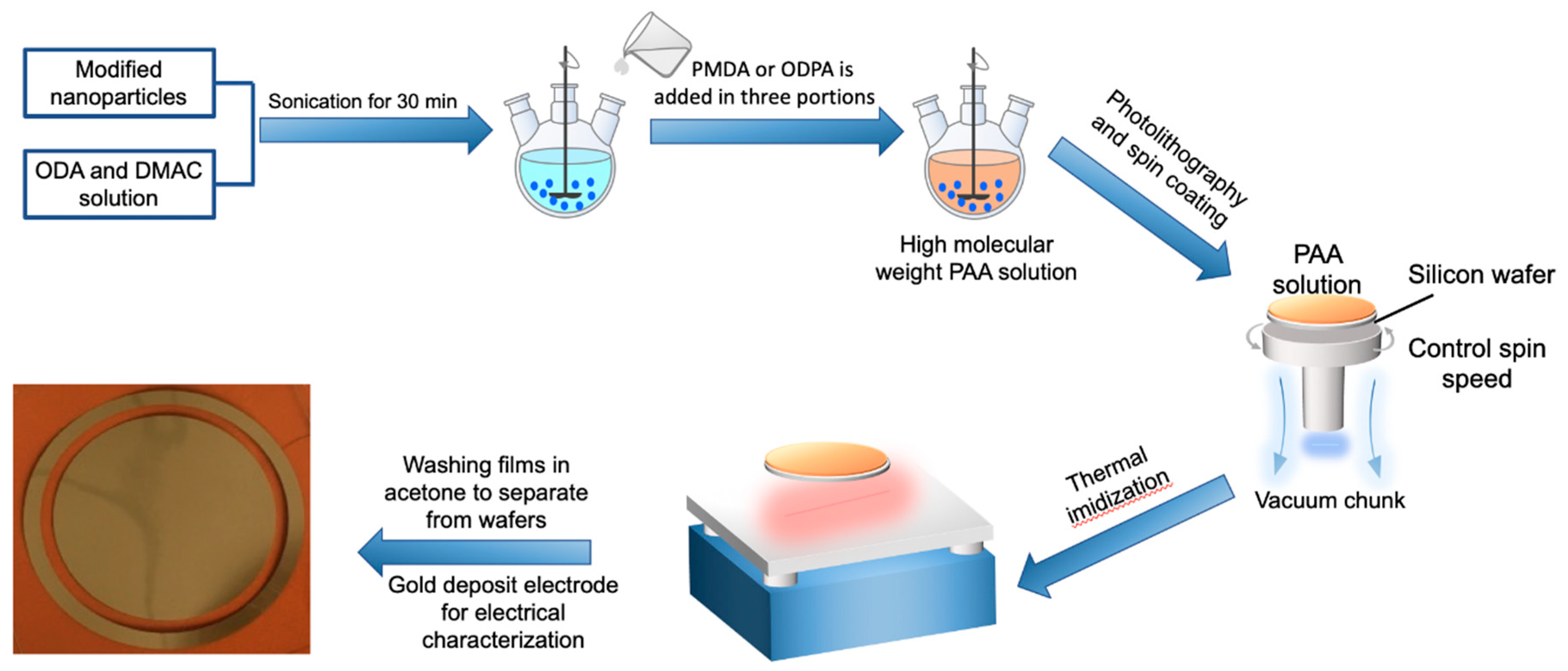
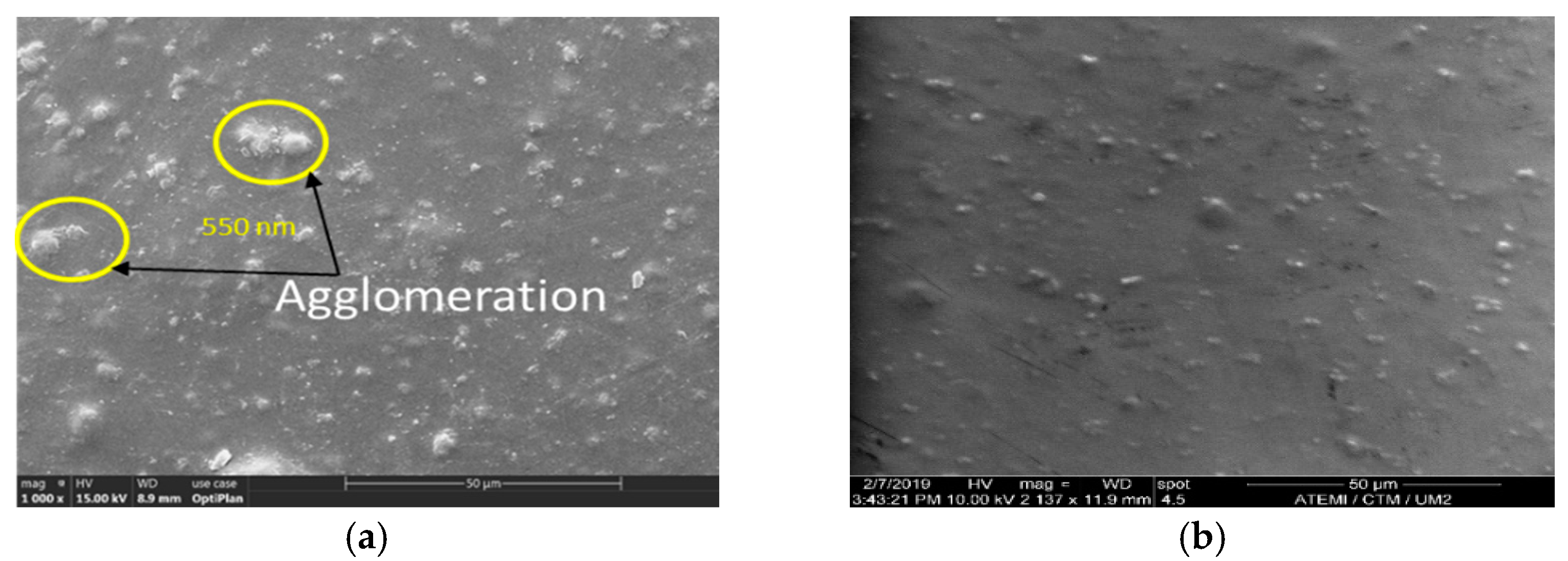
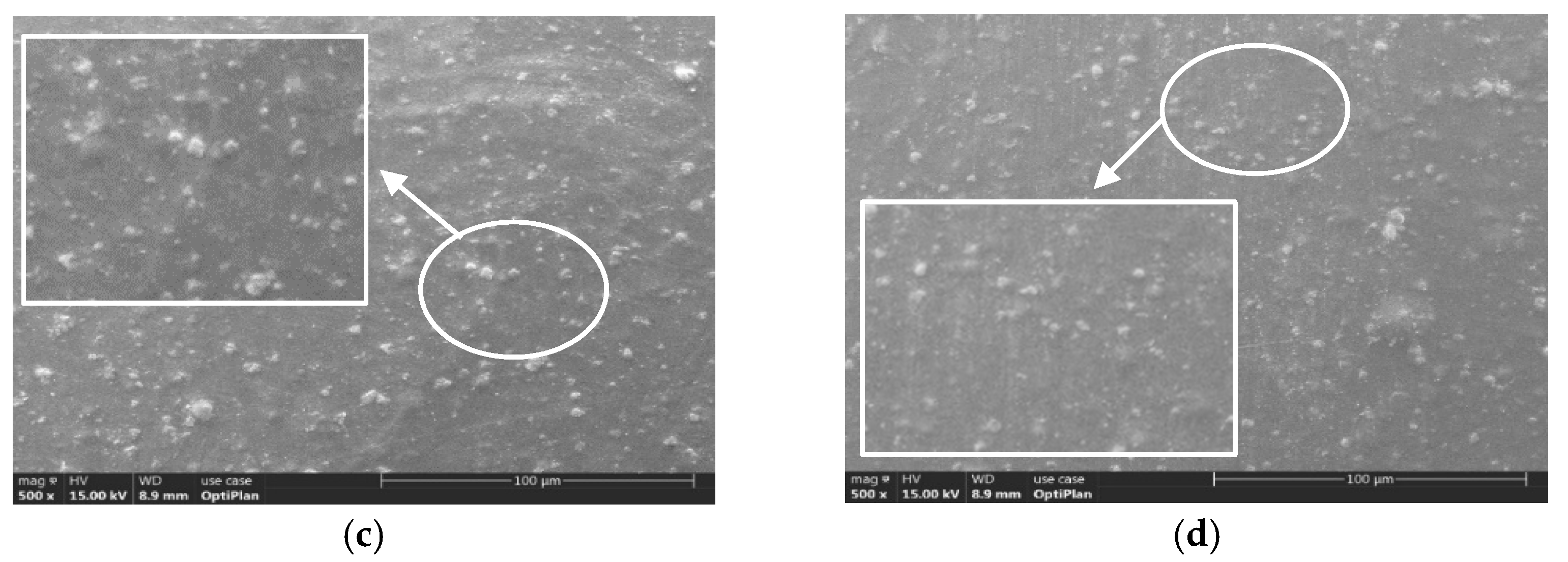
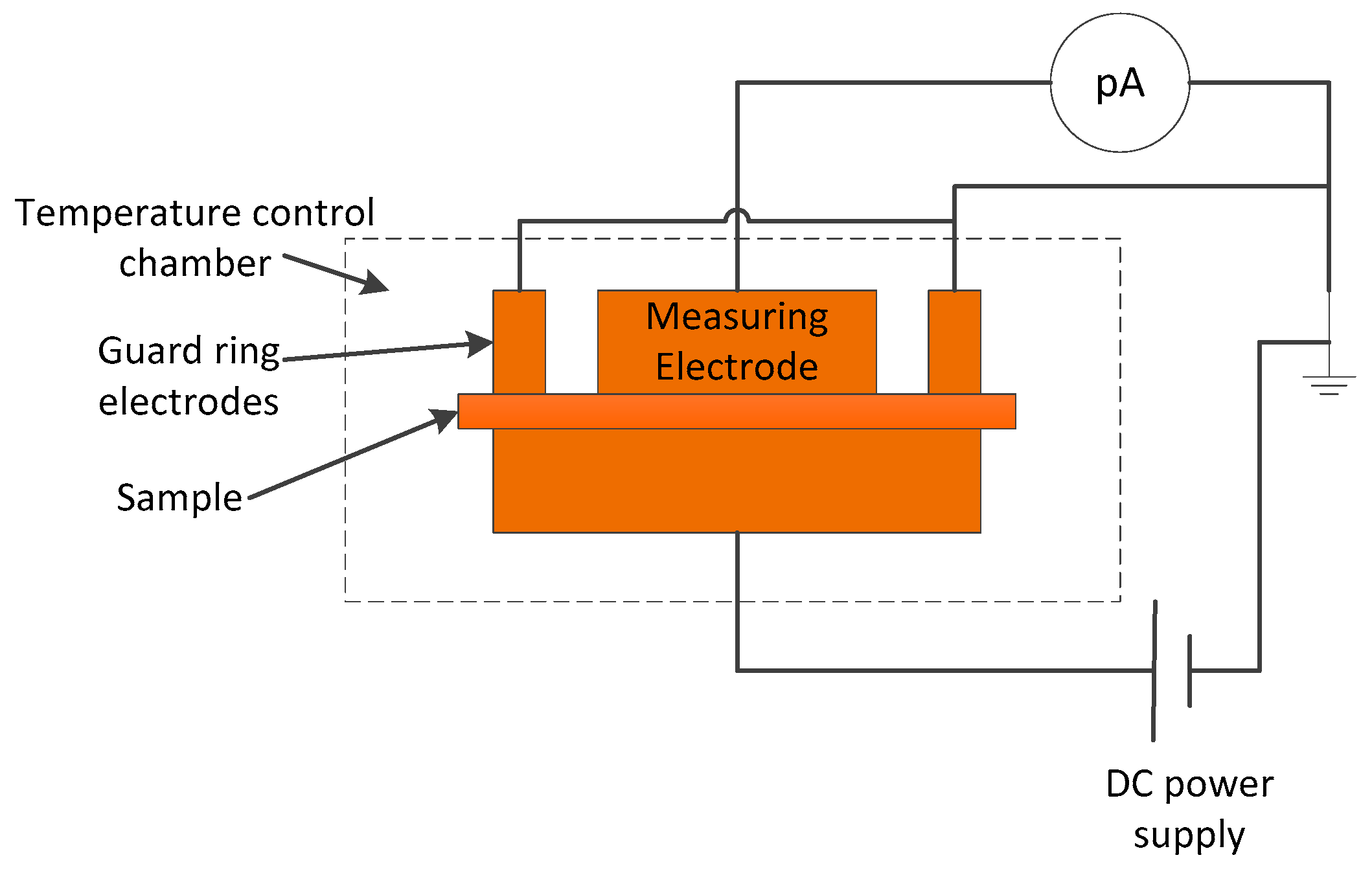
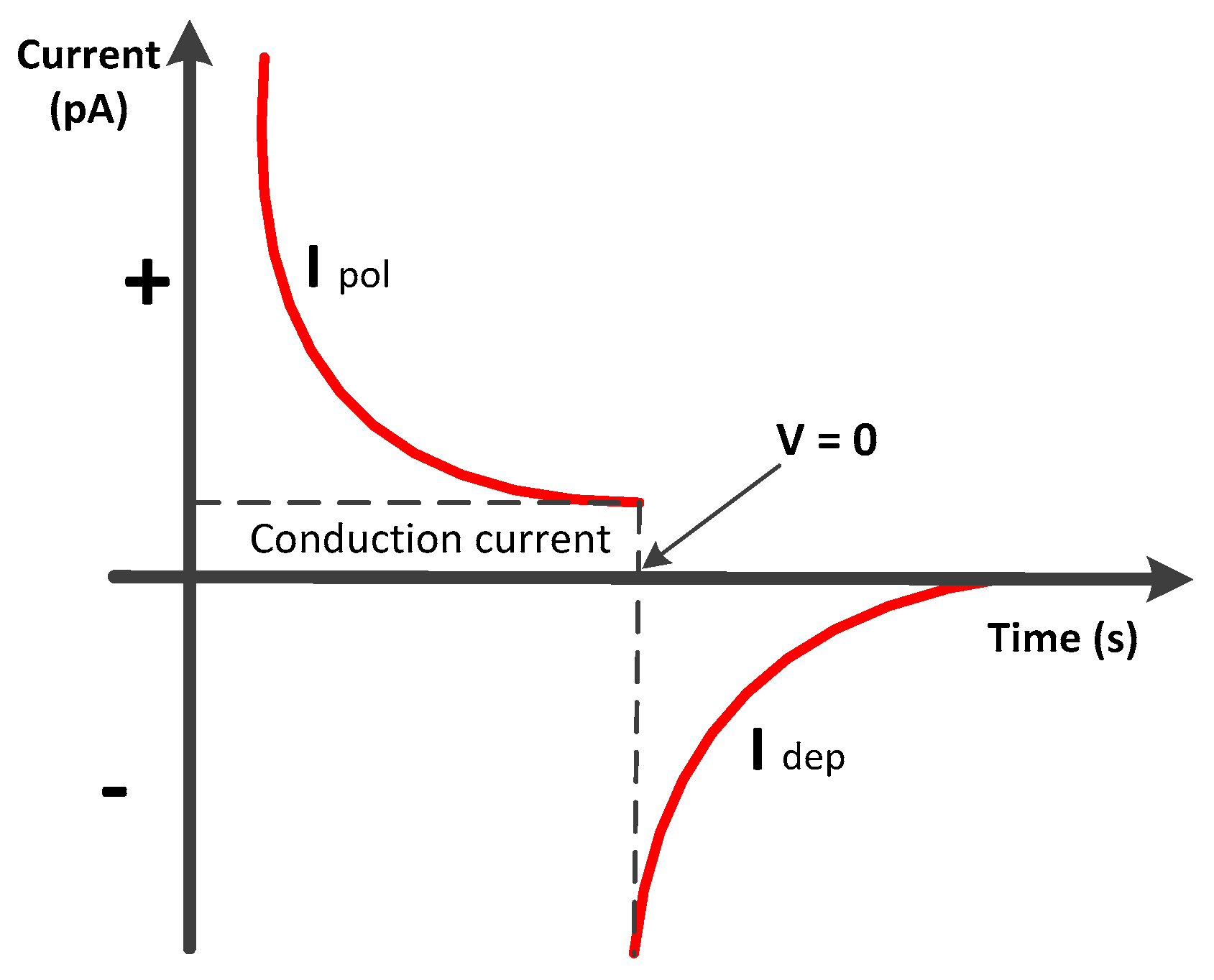
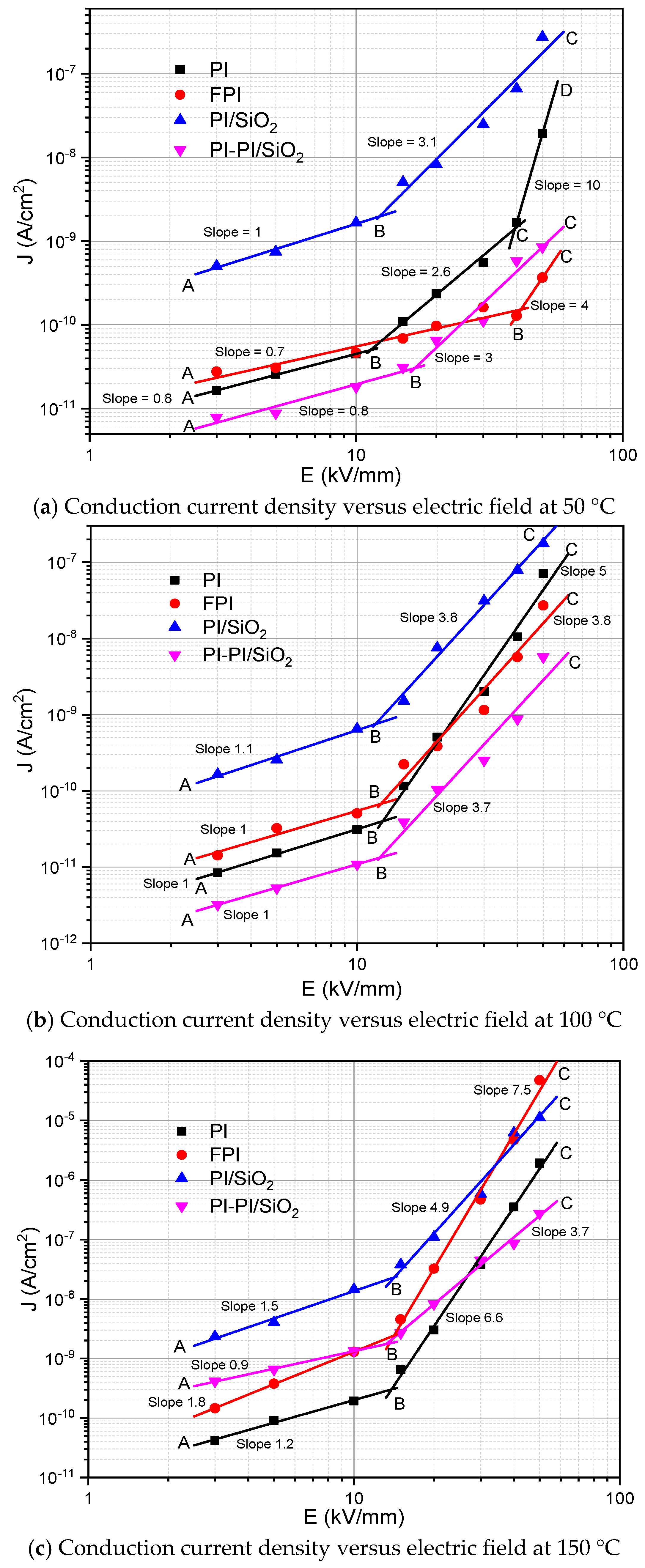
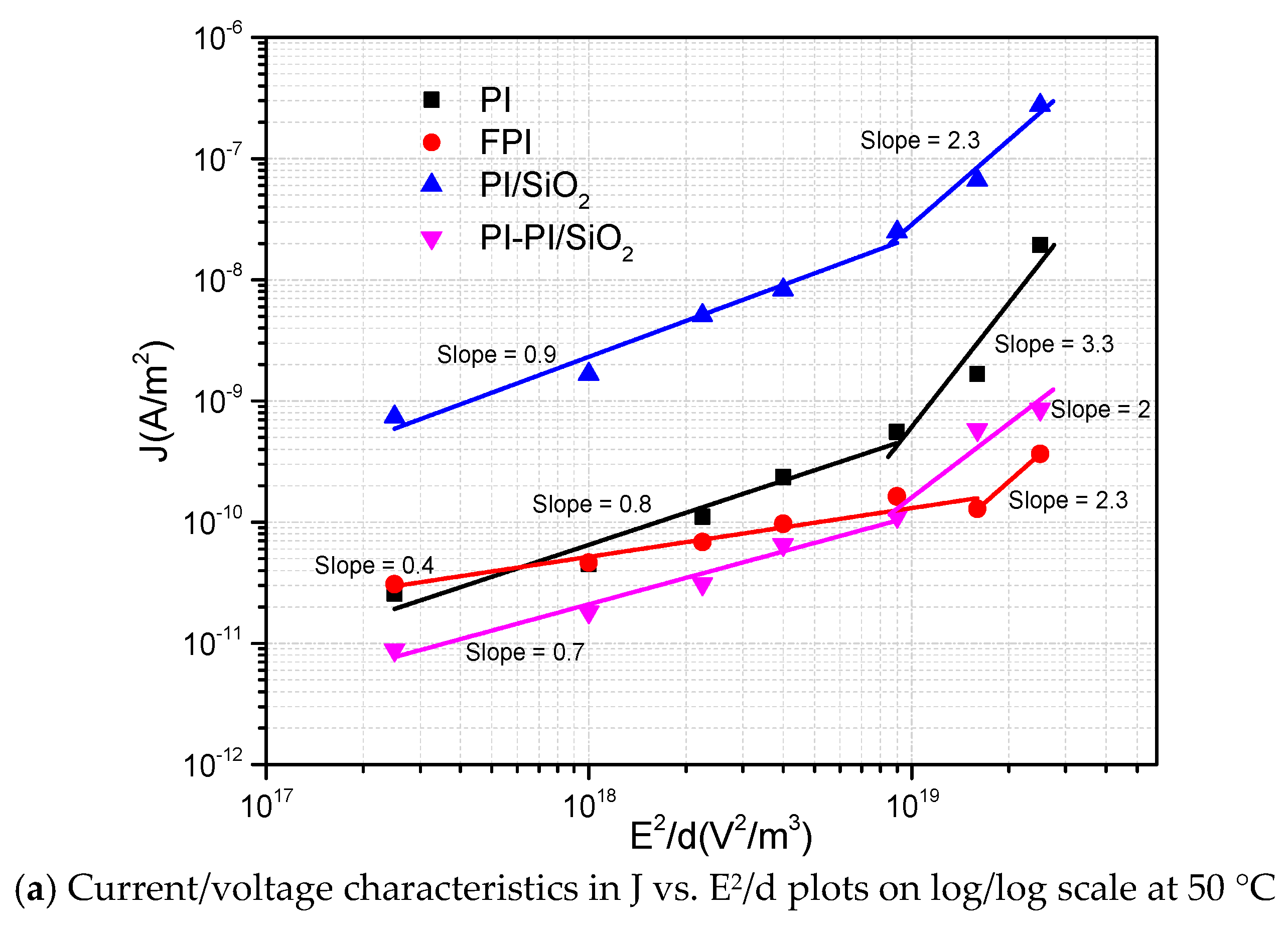

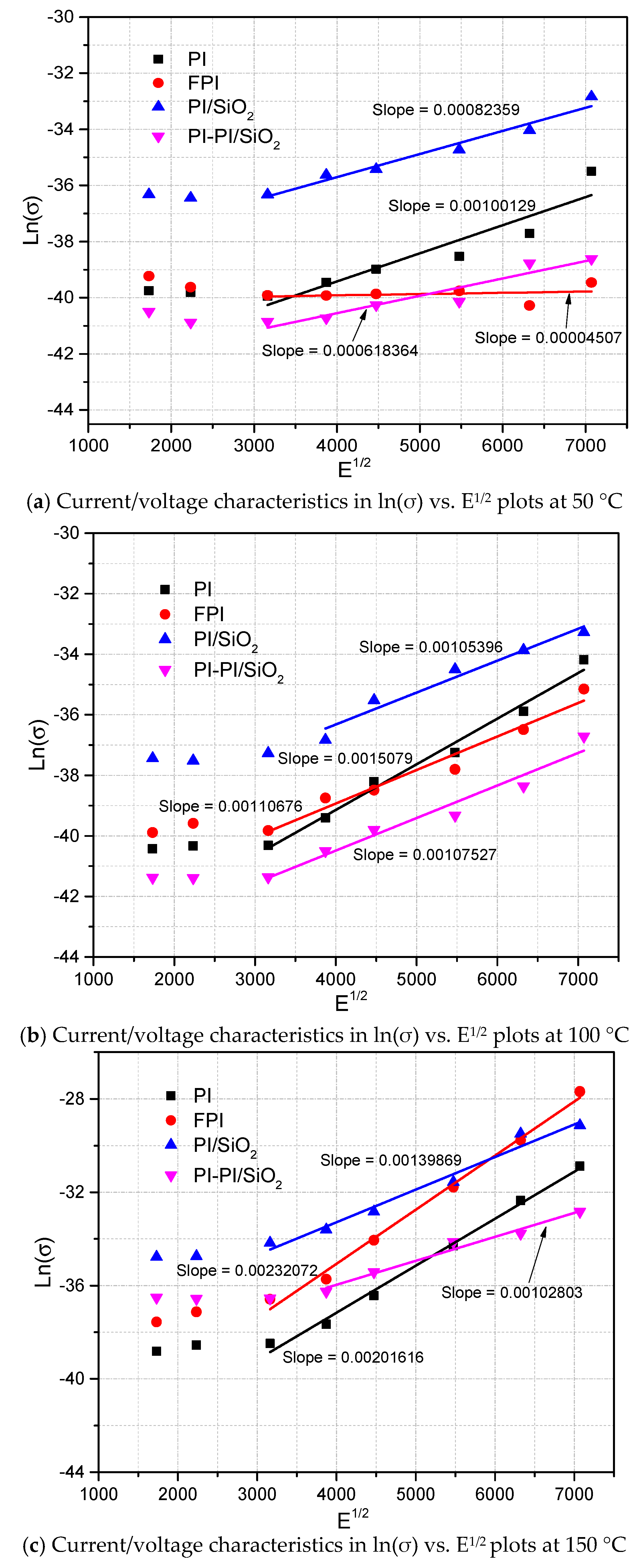
| Samples | εr (Measured) | Slope | ΒPF/kT | εr (Calculated) | Temperature (°C) |
|---|---|---|---|---|---|
| PI | 3.9 | 1 × 10−3 | 1.4 × 10−3 | 2.3 | 50 |
| FPI | 3.6 | 0.4 × 10−4 | 1.4 × 10−3 | 6.1 | |
| PI/SiO2 | 3.95 | 0.8 × 10−3 | 1.4 × 10−3 | 9.2 | |
| PI-PI/SiO2 | 3.98 | 0.6 × 10−3 | 1.4 × 10−3 | 15.1 | |
| PI | 4 | 1.5 × 10−3 | 1.2 × 10−3 | 2.4 | 100 |
| FPI | 3.6 | 1.1 × 10−3 | 1.2 × 10−3 | 4.6 | |
| PI/SiO2 | 3.65 | 1 × 10−3 | 1.2 × 10−3 | 5.5 | |
| PI-PI/SiO2 | 3.63 | 1 × 10−3 | 1.2 × 10−3 | 5.5 | |
| PI | 3.8 | 2 × 10−3 | 1.1 × 10−3 | 1 | 150 |
| FPI | 3.6 | 2.3 × 10−3 | 1.1 × 10−3 | 0.8 | |
| PI/SiO2 | 3.5 | 1.4 × 10−3 | 1.1 × 10−3 | 2.2 | |
| PI-PI/SiO2 | 3.58 | 1 × 10−3 | 1.1 × 10−3 | 4.3 |
Publisher’s Note: MDPI stays neutral with regard to jurisdictional claims in published maps and institutional affiliations. |
© 2021 by the authors. Licensee MDPI, Basel, Switzerland. This article is an open access article distributed under the terms and conditions of the Creative Commons Attribution (CC BY) license (http://creativecommons.org/licenses/by/4.0/).
Share and Cite
Bhutta, M.S.; Akram, S.; Meng, P.; Castellon, J.; Agnel, S.; Li, H.; Guo, Y.; Rasool, G.; Hussain, S.; Nazir, M.T. Steady-State Conduction Current Performance for Multilayer Polyimide/SiO2 Films. Polymers 2021, 13, 640. https://doi.org/10.3390/polym13040640
Bhutta MS, Akram S, Meng P, Castellon J, Agnel S, Li H, Guo Y, Rasool G, Hussain S, Nazir MT. Steady-State Conduction Current Performance for Multilayer Polyimide/SiO2 Films. Polymers. 2021; 13(4):640. https://doi.org/10.3390/polym13040640
Chicago/Turabian StyleBhutta, Muhammad Shoaib, Shakeel Akram, Pengfei Meng, Jerome Castellon, Serge Agnel, Hui Li, Yecai Guo, Ghulam Rasool, Shahid Hussain, and Muhammad Tariq Nazir. 2021. "Steady-State Conduction Current Performance for Multilayer Polyimide/SiO2 Films" Polymers 13, no. 4: 640. https://doi.org/10.3390/polym13040640
APA StyleBhutta, M. S., Akram, S., Meng, P., Castellon, J., Agnel, S., Li, H., Guo, Y., Rasool, G., Hussain, S., & Nazir, M. T. (2021). Steady-State Conduction Current Performance for Multilayer Polyimide/SiO2 Films. Polymers, 13(4), 640. https://doi.org/10.3390/polym13040640












